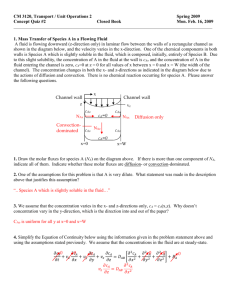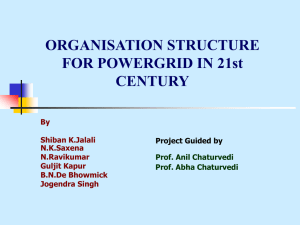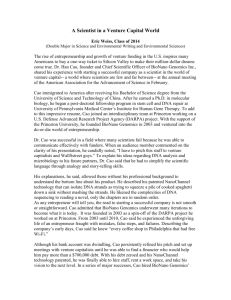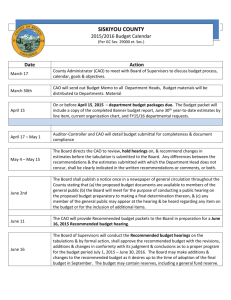Chapter 10A
advertisement
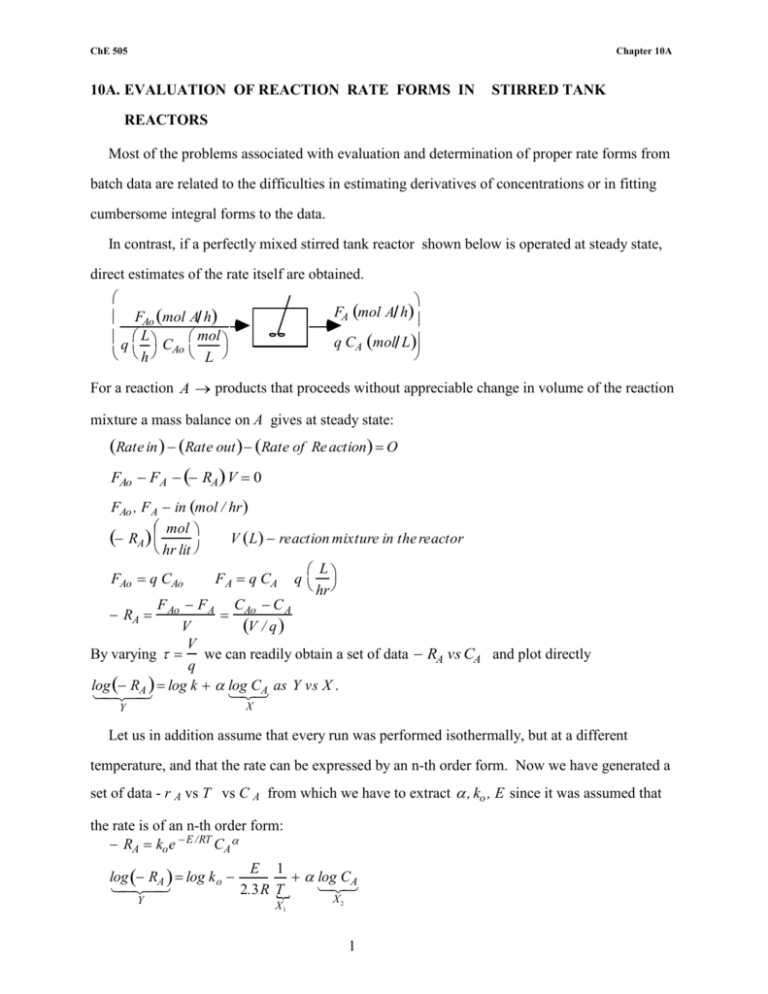
ChE 505 Chapter 10A 10A. EVALUATION OF REACTION RATE FORMS IN STIRRED TANK REACTORS Most of the problems associated with evaluation and determination of proper rate forms from batch data are related to the difficulties in estimating derivatives of concentrations or in fitting cumbersome integral forms to the data. In contrast, if a perfectly mixed stirred tank reactor shown below is operated at steady state, direct estimates of the rate itself are obtained. FAo mol A h q L C mol h Ao L FA mol A h q CA mol L For a reaction A products that proceeds without appreciable change in volume of the reaction mixture a mass balance on A gives at steady state: Rate in Rate out Rate of Re action O FAo FA RA V 0 FAo , F A in mol / hr RA mol V L reaction mixture in the reactor hr lit L FAo q CAo F A q CA q hr F F A CAo C A RA Ao V V / q V By varying we can readily obtain a set of data RA vs CA and plot directly q log RA log k log CA as Y vs X . X Y Let us in addition assume that every run was performed isothermally, but at a different temperature, and that the rate can be expressed by an n-th order form. Now we have generated a set of data - r A vs T vs C A from which we have to extract , ko , E since it was assumed that the rate is of an n-th order form: RA ko e E /RT CA log RA log k o Y E 1 log CA 2.3R T X1 X2 1 ChE 505 Chapter 10A Say we had N-measurements. Then Yi A B X1i CX 2i ; i 1,2... N X1i 1 Ti ; X2i log CAi Yi log RA predicted at i ; A log k o , B E ,C 2.3 R X1i , X2i , Yi are known at every data point. We want to minimize the sum of the squares of the errors E yi Yi where yi log RAi measured at point i. N S wi yi Yi 2 i1 S S S O A B C which yields the three linear equations for best estimates of A,B,C (when wi = 1) N N N yi AN B X1i C X2i i1 N i1 N i1 N N yi A X1i B X 1i C X1i X2i i1 N i1 N i 1 2 i1 N N X2i yi A X2i B X1i X2i C X 2i i1 i1 i1 2 i1 Thus, multiple linear regression can be used successfully to determine all three parameters but at some loss of statistical rigor due to the logarithmic transformation performed. Often multiple linear regression is adequate to determine the parameters with satisfactory accuracy. When further refinements are needed, one should use the results of linear regression analysis as the starting estimates of the parameters and proceed to refine them by nonlinear regression. Suppose we wanted to find now the values of parameters that minimize the sum of the squares of errors in the original space. Now S is defined by: N S yi Ae i1 BX 1i C 2 X 2i wi A All of the techniques will rely on some sort of iteration scheme. Briefly if P B is the vector C of parameters and P k is the k-th guess for parameters, P k1 is k 1 improved guess given by P k1 k P RG 2 ChE 505 Chapter 10A where T S S S G A B C P k is the gradient vector in the direction of increasing (decreasing S), R is a matrix, the components of which determine whether in search of the minimum of S we will move directly in the gradient direction or at some angle to the gradient direction, is a scalar regulating the size of the step taken in improving the parameter value. For example if R I is the identity matrix 1 0 0 R 0 1 0 0 0 1 P k 1 P k G and we have the steepest descent method. If, however, R is related to the Hessian matrix 1 2 S 2 S 2 S A 2 A B A C 2 S 2 S 2 S R A B B2 B C 2 2 2 S S S A C B C C 2 one has the Newton-Raphson Method, and with approximations to R the Gaus-Newton Method. Some available computer programs would require explicit expressions for the partial S 2 S , , etc. to evaluate G and R . Others estimate them by finite differences. derivatives A A B Further information on parameter estimation in rate equations can be found in: 1. Hanns Hofmann, "Industrial Process Kinetics and Parameter Estimation", in 1st Int. Symp. Chem. React. Eng. (H. Hulburt, editor), Advances in Chemistry 109, pp 519-534 (1972). 2. John H. Seinfeld and Leon Lapidus, "Mathematical Methods in Chemical Engineering, Vol. 3 Process Modeling, Estimation and Identification", Chapter 7, pp. 339-418, Prentice-Hall, N.J. (1974). 3 ChE 505 Chapter 10A 10A.1 Review of Kinetic Forms The following few pages summarize the integrated most commonly encountered kinetic forms in batch reactors. Only the frequently encountered reaction rates for single reactions are integrated and presented. Expressions for some simpler multiple reactions can also be readily found and are given in almost all textbooks (Carberry, Levenspiel, etc.). We have seen that reaction rates are functions of temperature and composition and usually are much more sensitive to changes in temperature than in composition (i.e the rate changes much more dramatically with temperature than with composition). Consider an n-th order irreversible reaction RA k oe E /RT n CA with E = 20,000 cal; n = 2. At constant temperature doubling the concentration would increase the rate by a factor of 4. However, doubling the temperature from 300K to 600K would increase the rate at constant concentration by a factor of 17 x 106, i.e, seventeen million times! An increase of 27o i.e of 1.09 times the original temperature (less than 10%) would increase the rate by a factor of 4. Thus, for single irreversible reactions we should choose the highest allowable temperatures in order to get the highest rates. For a reversible reaction the problem is slightly more complicated. For example, for a first order reversible reaction we have RA k10e E1 / RT CA k20e E2 /RT CP for a reaction A = P. At equilibrium - RA = 0 . k10 e k 20 ( E 1 E 2 ) RT CP CAo x A xA e 1 x Ae Kc C P Kc CA eq CA CAo 1 x A x Ae Kc 1 Kc Now, if we raise the concentration of A, the net rate forward will increase while the equilibrium remains unaffected. 4 ChE 505 Chapter 10A 1.0 locus of maximu m rates direction of increasing rates xA -RA =0 (X A ) e T Figure 1a. Conversion vs Temperature for an Exothermic Reaction -RA =0 (X A) e xA T Figure 1b. Conversion vs Temperature for an Endothermic Reaction If we raise the temperature, the rate will increase both in forward and reverse direction, the portion of the rate with the higher activation energy will increase more and the equilibrium will be affected. In the above example H E E . K K RT j . For this example 1 2 c P j O and thus d n Kc H dT RT 2 dKc dK 1 Kc c dX Ae Kc dK c dT dT 2 2 dT 1 Kc 1 Kc dT d n Kc K 2c H 2 2 1 Kc dT 1 Kc RT 2 dx A e The sign of the above derivative syn depends exclusively on the sign of H since all dT dx A e other terms are positive. Thus 0 for H 0 i.e endothermic reactions, and dT Kc2 xAe goes up as temperature rises 5 ChE 505 Chapter 10A X xAe as T . See Figure 1b. dx A e 0 for H 0 i.e exothermic reactions, and the equilibrium conversion drops as the dT temperature rises x A e as T . See Figure 1a. This conclusion can be generalized and it holds for all types of reversible reactions. Thus, in principle for every reversible reaction we could plot on a conversion versus temperature plot a locus for the equilibrium conversion as function of temperature and loci of constant rates. The locus of constant rates is obtained by connecting the points in the x A vs T plane which have the same rates. For endothermic reactions no peculiar behavior is observed (Figure 1b). The higher the temperature at fixed conversion the higher the rate, i.e if we travel along a line parallel to T-axis from left to right we will cross the lines of constant rates moving from lower to higher rates. At constant temperature the lower the conversion (the higher the reactant concentration) the higher the rate i.e, when moving from the top to the bottom along a line parallel to x A - axis we will constantly get into regions of higher rates. For exothermic reactions, we can quickly observe (Figure 1a) that at constant temperature T the lower the conversion the higher the rate. However, when we look at lines of constant conversion x A we see that if we move from left to right we go through a region of increasing rates, hit a maximum rate and go then through a region of decreasing rates. Thus, we can plot on the x A vs T diagram a locus of maximum rates. For the given example of first order reversible exothermic reaction this locus would be obtained as follows: RA k10eE1 / RT CAo 1 xA k20eE2 / RT CAo xA E E d RA 12 k10 e E1 / RT CA o 1 x A 22 k20 e E 2 / RT CA o x A dT RT RT k10 e E1 /RT CAo k 20 e E2 /RT CAo d x A Now for the loci of constant rates - RA = const, d ( -RA ) = 0 and E1 E2 k 2x A 2 k1 1 x A dx A RT RT 2 dT RA cons t k1 k2 If we want to identify the points at which the loci of constant rates go through maxima in the x A vs T plot then at those points we must have: 6 ChE 505 dx A dT Chapter 10A R A const 0 which leads to: E1k1 1 x A E2 k2 x A 0 E k 1 x E1 E 2 A E1k10 e x A 1 10 e RT 1 0 E2 k20 E1 k20 1 x A E E2 e 1 E2 k20 x A RT E1 / RT Tm E1 E2 E2 E1 E k 1 x A E k x R n 1 10 R n 2 20 A E2 k20 x A E1k10 1 x A This is the locus of maximum rates (the dashed line on our graph) in Figure 1a. In other words, pick a set of values for 0 x A x Ae T min and from the above formula calculate the corresponding T . Every pair x A - T represents a point on the locus of maximum rates. By solving for conversion one can express the locus of maximum rates as 1 xA E2 k20 E E2 exp 1 1 E1k10 RT Thus, one can pick a set of values for temperature, T , in the region of interest, and from the above formula calculate the corresponding x A. Every pair x A - T is a point on the locus of maximum rates on our graph (dashed line). The above expressions were developed for a first order reversible reaction only. Nevertheless the procedure can be readily generalized for any rate form r r dr dT dx A 0 T xA dx A dT r T 0 r r const x A The locus of maximum rates can thus always be obtained by setting r 0 T The above discussion leads to two basic conclusions. In the case of reversible endothermic reactions, the higher the temperature the higher the rate and the more favorable the equilibrium. 7 ChE 505 Chapter 10A For reversible exothermic reactions, the higher the temperature the less favorable the equilibrium. Thus, in a batch system one should move along the locus of maximum rates by starting at high temperature and then as conversion increases, lower the temperature accordingly in such a manner that at every temperature T one stays at the maximum of the rate loci. Towards the end of reaction low temperature will allow favorable equilibrium while the rates will still stay as high as possible at that temperature. Besides being affected by temperature, the equilibrium composition is also affected by initial composition. For example for a reaction aA = pP CA xA Kc a C A 1 x A p o e a o C Ao pa x A ep 1 x Ae e const at fixed T a Differentiating the above with respect to CAo we get 0 p a CAo x Ap p a1 e 1 x A a a1 p x A p1 1 x A a 1 x A x A p dx A 2a d CA 1 x A a e CAo p a e e e e o e Thus, the sign of sgn d x Ae d CA o dx Ae d CAo e depends only on p-a p a This can readily be generalized to: S dx Ae sgn j dCAo j1 If the reaction proceeds with an increase in the number of moles then j 0 and the equilibrium conversion decreases with increased initial concentration i.e CAo x A e . If the reaction proceeds with the decrease in the number of moles conversion increases with increasing CAo j O and equilibrium i.e CAo x Ae . This of course assumes ideal mixtures in which the activity or fugacity coefficients will not change with composition. mol For example, consider A = 2P, a = 1, p = 2 at the temperature at which Kc 1 . If we lit mol start with CAo 1 the attainable equilibrium conversion is obtainable from the expression lit 8 ChE 505 Chapter 10A for the equilibrium constant: CAo x Ae x A 2e K c and x Ae 1 x Ae 1 1 1 4 0.618 2 Kc K 2c Kc 2 4 CAo C Ao CAo 2 If at the same temperature we started with 1 1 1 1 mol CAo 2 ; x 4 x 0.5 A e lit 2 2 4 2 Since j 2 1 1 O asC A o x Ae as stated above. The effect of total pressure on the equilibrium constant is d n KP V dP RT dx A e Thus, sgn V dP For a reaction that is accompanied by an increase in volume V O an increase in pressure on the system will reduce the equilibrium conversion, i.e P x Ae . For a reaction that is accompanied by a decrease in volume V O an increase in pressure on the system will increase the equilibrium conversion i.e P x Ae . For multiple reactions similar conclusions can be drawn. If the activation energy for the reaction of desired product formation is the highest, the optimum yields will be obtained at the highest temperature. If the activation energy for formation of the desired product is the lowest, the lowest temperature will maximize the yield but the rates may be too slow then, so a compromise has to be found. If the activation energy for desired product formation is in between then an optimum temperature profile exists which would maximize the yield. Various integrated rate forms are in the appended tables. 10A.2 Rate Forms Other Than n-th Order So far we have mainly discussed the n-th order type rate forms. For an irreversible reaction at constant temperature these rate expressions can be plotted against concentration of the limiting reactant or conversion. (See Figure 2). All these rates have one thing in common, i.e they never decrease with increasing concentration of the limiting reactant (or other reactants), or mathematically 9 ChE 505 d RA d CA Chapter 10A 0 for all 0 CA CA o These are "well behaved" rate expressions. We should watch for possible peculiar behavior when we encounter a rate which can decrease at least over some reactant concentration range with increasing reactant concentration i.e, for rates where d RA 0 for CAc " CA CA c ' d CA n=1 n<1 n>1 -RA n=0 CA or (1 - x A) Figure 2. n-th Order Rate Behavior -RA 1 2 CA Figure 3. Non n-th Order Rate Behavior Two of such rates are presented in Figure 3. The first one (1) results from autocatalytic reactions A + P= P + P - RA = k CACP , the other (2) is observed in a number of catalytic processes with 10 ChE 505 self inhibition RA k CA K CA 2 Chapter 10A . In these particular situations the rate is low at high reactant concentrations, reaches the maximum at some C A and then decays again as the reactant concentration is further depleted. It is worth considering autocatalytic reactions in a little more detail. For example A PP P with a rate of RA k CACP From stoichiometry Co CAo CA CP CPo ; CP CPo CAo CA In a batch system then: dC RA A k CA Co CA dt The rate reaches a maximum value when d RA C 0 Co 2CA CA o or d CA 2 CAo 1 x A Co C xA 1 o 2 2CAo Then the rate takes its maximum value of C C C2 RAmax k o Co o k o 2 2 4 If CAo f Co where 0 < f < 1 the ratio of the maximum rate and initial rate is 2 RAmax RAi nit ial Co 1 4 k f Co Co f Co 4 f 1 f k Thus, if the initial solution contains 99% A and 1% P (which is reasonable since P serves only to start the reaction) f = 0.99 and the maximum rate is over 25 times larger than the initial rate. The integrated form of the rate expression is: CA Co CA n o k Co t CA Co CAo C The maximum rate at CA o would be reached after time of 2 11 ChE 505 t max CA f 1 1 f 1 o n n n 1 f k Co 1 f k Co Co CAo k Co Chapter 10A The larger the f is the larger the time t max necessary to reach maximum rates. This implies that if the product is present as an impurity at 0.1% level (f = 0.999) the rate of reaction may go unnoticed initially but would peak to 250 times larger value after k Co t = 6.9. Autocatalytic reactions should be viewed in a broader sense than presented here. Specifically, autocatalytic reactions become especially dangerous when they proceed in the gas phase with an increase in the total number of moles of the reaction mixture (say A + P = 3P) and are exothermic. In that case a slow initial reaction is accelerated on one hand due to the autocatalytic effect of the product and on the other hand due to the increased temperature caused by the heat of reaction. The rapidly rising pressure of the system due to the expanding reaction mixture volume may, and occasionally does, cause explosions. Even for reactions in the liquid phase rapidly accelerating reaction due to a combined autocatalysis-temperature (caused by exothermicity) effect may lead to rapid build-up of the vapor phase and to explosions. Thus, autocatalytic reactions and all reactions that exhibit rate forms which allow for increases in rates with diminishing reactant concentrations should be watched for and dealt with cautiously. Autocatalytic reactions can be viewed even in a broader sense than that. For example heat released by a slow reaction causing the same or a similar reaction to accelerate rapidly is also viewed by some as an autocatalytic effect in that reaction system. As an example of autocatalysis let us consider the hydrolysis of an ester RCOOR' in dilute water solution: RCOOR' E ester H2 O RCOOH R' OH W A B water acid booze The reaction proceeds without the catalyst at a very slow rate. However, the acid, product of reaction, catalyzes the same reaction at much faster rates. RCOOR' E RCOOH H2 O RCOOH R' OH A W A B The total rate of disappearance of the ester can be given as the sum of the rate of the spontaneous 12 ChE 505 Chapter 10A ("residual") reaction and of the catalytic reaction dCE ks CE kc CE CA dt From stoichiometry CEo CE CA CAo also CE CE o 1 x E CA CAo CEo x E If we started initially with pure reactants CAo 0 in a batch system, the governing equations dCE dx CE o E ks CE o 1 x E kc C2Eo 1 xE x E dt dt at t 0 CE CEo or x E 0 Note: The reaction rates for both the residual and catalytic reaction were presumed independent of water concentration (zeroth order with respect to water) since water is present in large excess. dx E ks 1 x E kcCE o x E 1 xE dt at t 0 xE 0 Upon integration we get 1 kc CEo t 1 k cC Eo t e 1 1e xE 1 k C t 1 k cC Eo t 1 e e c Eo where ks kcCE o 1 kc CE o 1 1 ks 1 has units of (time) and is a measure of the characteristic reaction time for the residual ks reaction, i.e gives the time scale over which that reaction takes place. 1 has units of time and is a measure of the characteristic reaction time for the catalytic kc CEo reaction. Clearly the time scale for the much faster catalytic reaction is much smaller than the time scale for the residual reaction and thus 1 . 1 kc CE t becomes a proper dimensionless time for the process overall. 1 e xE e o The maximum rate is achieved when 13 ChE 505 xE 1 1 ; n ; t 2 1 kcCE o 1 n Chapter 10A CE2o CEo C k s kc E o kc 2 2 4 RE max The ratio of the maximum rate to the initial rate of the residual reaction is: CEo ks kcCE o RE max 2 2 1 1 1 1 1 RE si nit ks CEo 2 2 4 10A.3 Some Comments on the Variable Volume Batch System We have derived some time ago how the volume of the reaction system varies with reaction extent for an ideal mixture of ideal gases: S j j1 V Vo 1 X NT o Molar extent can be expressed in terms of fractional conversion since N N Ao NP N Po X A etc A xA X P NA o NA N Ao N Ao A xA N Ao A xA Then V Vo 1 A xA where the coefficient of expression A is defined by: S j yAo V x A 1 V xA O j1 A A V x O A y Ao - mole fraction of A in the starting mixture. Let us suppose that we are considering the following irreversible n-th order reaction aA pP p a in a constant pressure batch reactor starting with pure A . The material balance on A yields dN A n kC AV dt 14 ChE 505 Chapter 10A We know that N A CAV but the volume now varies with reaction. d CA V d CA dV n V CA k CA V dt dt dt In order to integrate the above expression we need to know how V and dV vary either with dt concentration C A or with time t . We could start from: N CA A V In any system (constant P , or constant V ) by definition of convesion moles of A at time t are given by the initial moles of A times fraction unconverted, i.e: N A N Ao 1 x A and we have seen above: V Vo 1 A xA CAo C A 1 x A CA CAo or x A 1 A xA CAo ACA We could substitute x A in terms of CAo ,CA in the formula for the volume: 1 A CA o V Vo CAo ACA A 1 A CAo d CA dV Vo dt CAo A CA 2 dt d CA V After substitution in the first equation for dt CAo and some algebra we get d CA n k C A ; t 0 CA CAo CAo ACA dt p a x 1 p a For our example A a a It is of interest to note that if we did not remember the variation of reaction volume with extent or with conversion, and starting from d CA V dt V dCA dV n CA k CA V dt dt dV . It is instructive to go through that process. dt dV L The change in volume of the reaction mixture per unit time is proportional clearly dt min moles A to the total rate of disappearance of A, RAV multiplied by the change in volume of min we would have had to derive an expression for 15 ChE 505 L the reaction mixture per each mole of A reacted . mole A dV pa n n A k C A V (in our example) kC A V dt CAo aCA o Chapter 10A Now we would have two coupled differential equations to solve simultaneously. Since differential equations for concentrations lead to relatively complex forms it is advisable to use conversion whenever possible in variable volume systems. d CA V n kC A V dt 1 x A V V o 1 A x A but CA CA o 1 A xA CA V CAo Vo 1 x A d CA V dx 1 x A C Ao A k C nAo V o 1 A x A dt dt 1 A x A n n dx A 1 x A k C n1 Ao dt 1 A x A n1 n t0 xA 0 The equation for conversion can be more readily integrated for most orders and some of the integrated forms were given earlier. For example for first order reactions n dx A k 1 x A dt =1 xA 1 e k t This expression is exactly the same as in a constant volume system, since in the case of first order reactions it does not make any difference to conversion whether the process is performed at constant volume or constant pressure. The differential equation for concentration is for n = 1: CAo dCA k CA CAo A CA dt CA C A CA A CA CA n CAo o o t CA o d CA AC A CA 1 C C A Ao A o k dt o k t Solved for concentration this yields: 16 ChE 505 CA CAo e Chapter 10A kt 1 A 1e kt in V const We remember that in a constant volume system for first order reaction: CA CAo e k t V const Thus, although at given reaction time t fractional conversion for a first order reaction is the same in a V = const and P T = const system the reactant (or product) concentration is not. This is to be expected since in a V = const system the change in concentration is due exclusively to reaction. In P T = const system the change in concentration reflects the combined effect of depletion or formation of the number of moles by reaction and of volume expansion or contraction due to reaction. Naturally for A 0 (no expansion or contraction) the two expressions are identical. 17

